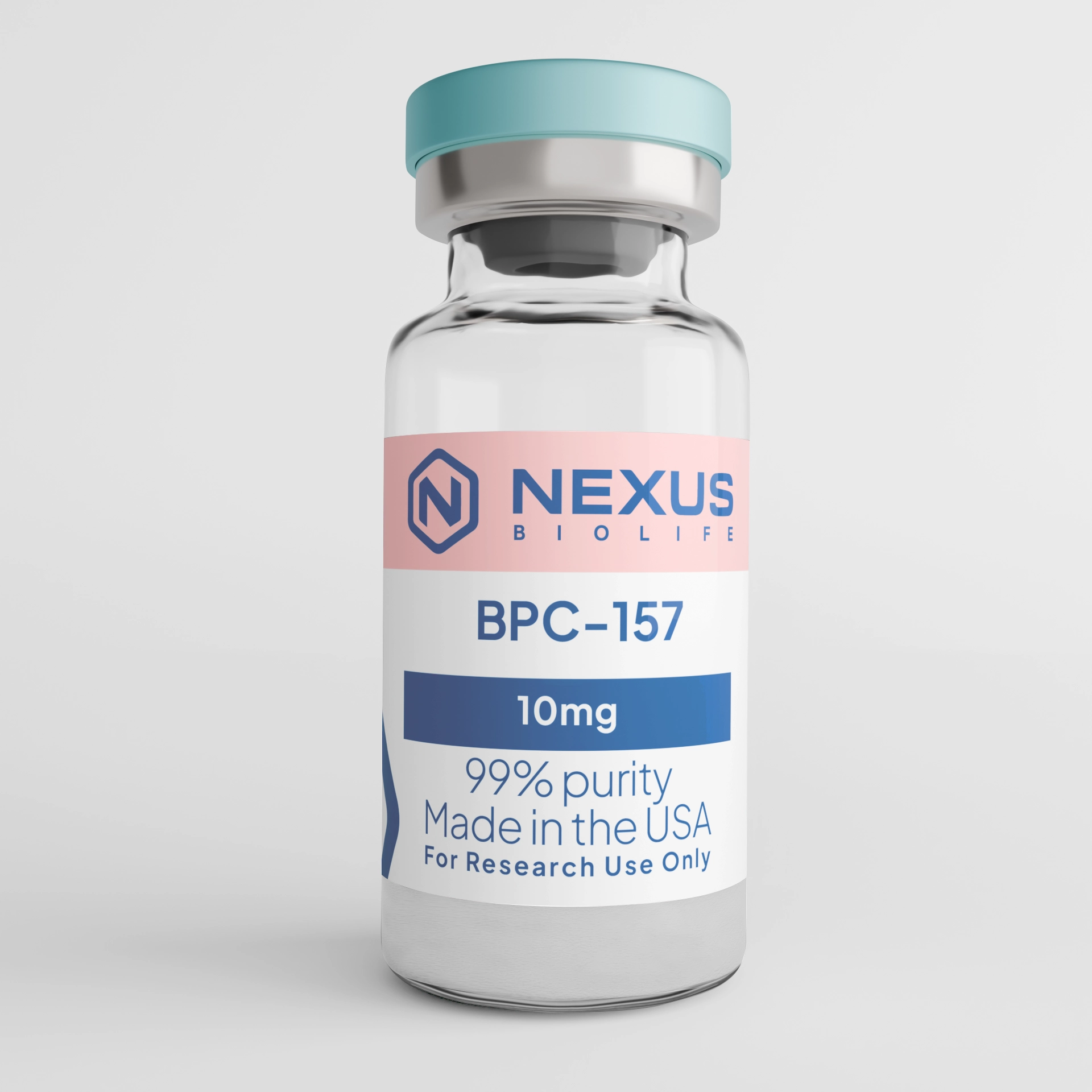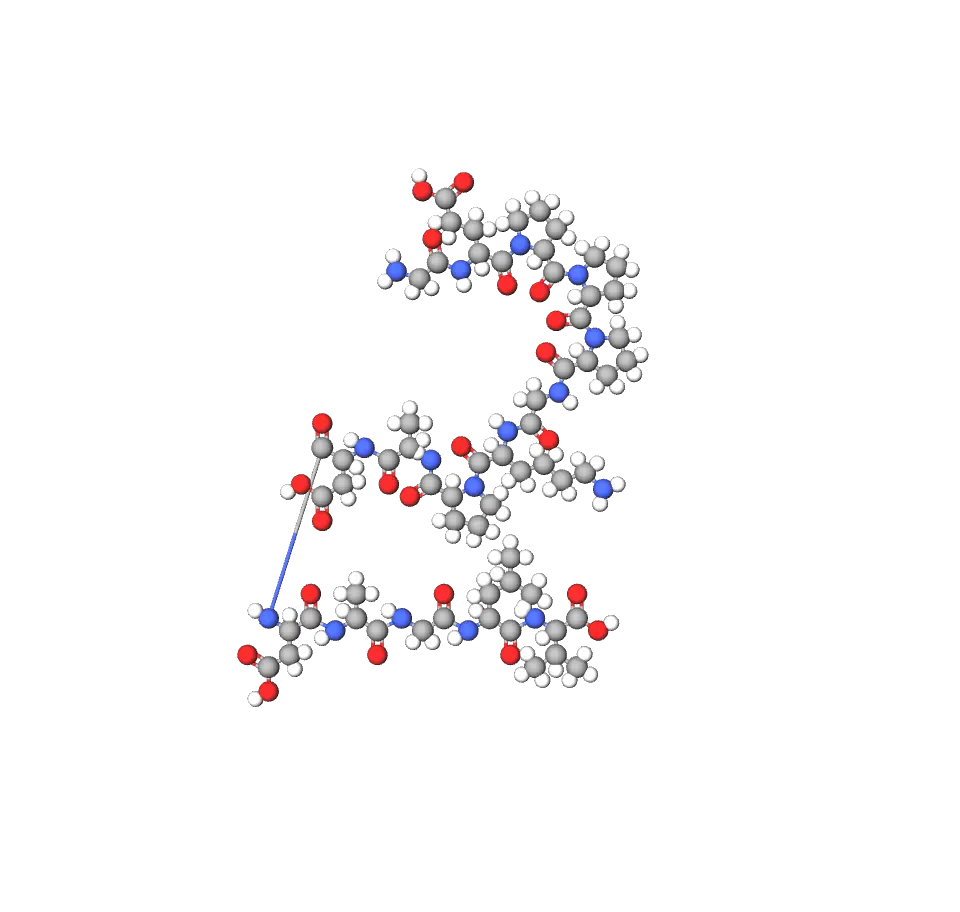
BPC-157 is a synthetic peptide meticulously prepared for scientific inquiry. This product offers a purity level of 99%. It is utilized in various laboratory investigations. BPC-157 is designated solely for research and development purposes.

Structurally, BPC-157 is a linear chain of 15 amino acids with the formula C62H98N16O22 and a molecular weight of approximately 1419 Da. Its stability stands out, resisting enzymatic breakdown even in acidic environments, which allows for flexibility in experimental administration, such as oral or subcutaneous in animal studies. In vitro, it maintains integrity at room temperature and shows rapid metabolism into smaller fragments once in biological systems, with a short half-life under 30 minutes. Bioavailability varies by species and route, often around 14-51% in preclinical models. We handle these properties with a grounded approach: they're key for designing robust experiments, but our peptides remain exclusively for research and in-vitro exploration.
At our company, we're all about making peptide science approachable and reliable for researchers like you. BPC-157, a synthetic pentadecapeptide also known as Body Protection Compound-157, is a 15-amino acid sequence derived from a protective protein found in human gastric juice. With the amino acid sequence Gly-Glu-Pro-Pro-Pro-Gly-Lys-Pro-Ala-Asp-Asp-Ala-Gly-Leu-Val, this stable molecule has drawn interest in scientific studies for its potential cytoprotective and regenerative effects in various tissue models. In research environments, BPC-157 is examined for its role in promoting healing processes in experimental setups, strictly for in-vitro applications and not intended for any human use. Consider it a precise instrument for exploring tissue integrity and recovery pathways—compact, resilient, and full of investigative potential.
Looking back, BPC-157 was first identified in 1993 by researchers including Predrag Sikiric and colleagues during studies on gastric proteins. This discovery stemmed from isolating fragments of the larger Body Protection Compound (BPC) in human gastric juice, highlighting its natural origins in maintaining mucosal health. Over the years, preclinical investigations have expanded to explore its broader implications in animal models of injury and stress, building a body of evidence around its protective qualities. We're keen on these foundational stories as they anchor our commitment to evidence-based insights—clear, logical progress that supports researchers in piecing together the puzzle of peptide functionality without overstepping into unverified territory.
In summary, BPC-157 represents the innovative spirit of peptide research—a resilient fragment with wide-ranging potential in models of protection and regeneration. As your dependable partner in peptide research, we're delighted to supply such resources to inspire your explorations, always based on sound science and offered with an open, collaborative vibe. Whether investigating wound dynamics or organ resilience, BPC-157 serves as a steadfast ally in discovery. Let's advance understanding together, step by thoughtful step.
Researchers apply BPC-157 in diverse fields, such as orthopedic models for tendon-ligament healing, where it's tested in Achilles or MCL transection assays to assess recovery metrics. In gastrointestinal simulations, it's explored for colitis or anastomosis healing, often via oral routes to study mucosal repair. Neurological applications include ischemia/reperfusion models, examining its impact on hippocampal function. Broader uses span cardiovascular protection post-infarction or even apiary health against pathogens, highlighting its versatility. We uphold purity through HPLC and mass spec testing, ensuring transparency for your protocols.
Practically speaking: Store lyophilized at -20°C, reconstitute in sterile water or buffer for in-vitro work. Research dosages in models range from 10 μg/kg orally to micromolar concentrations in cell cultures—adjust per your study design. Critically, this peptide is for lab research only, not diagnostics, therapy, or human consumption. Safety profiles from preclinical data show low toxicity, but we prioritize ethics and compliance in all we do.
From an evidence-based view, BPC-157 has been associated with multifaceted activities in experimental contexts. It exhibits cytoprotective effects, safeguarding cells in models of organ damage, including the gastrointestinal tract where it may counteract ulcers and maintain mucosal integrity. Studies indicate it promotes angiogenesis by activating pathways like VEGFR2, potentially enhancing blood flow to injured areas without endothelium dependence in some cases. As an anti-inflammatory agent, it modulates responses in models of stress or trauma, reducing oxidative damage and supporting endothelial function via NO-related mechanisms.
In musculoskeletal research, BPC-157 appears to accelerate tendon and ligament repair by boosting fibroblast migration, collagen synthesis, and growth hormone receptor expression, leading to improved outcomes in transected models. Neuroprotective studies suggest it mitigates damage in brain ischemia or neuroleptic-induced models, possibly alleviating apoptosis and inflammation. It has also shown promise in wound healing, including fistulas and burns, by enhancing ECM formation and macrophage activity. Our rational take is that these observations underscore BPC-157's value in probing complex repair networks, always within ethical, controlled research frameworks.
At our company, we're all about making peptide science approachable and reliable for researchers like you. BPC-157, a synthetic pentadecapeptide also known as Body Protection Compound-157, is a 15-amino acid sequence derived from a protective protein found in human gastric juice. With the amino acid sequence Gly-Glu-Pro-Pro-Pro-Gly-Lys-Pro-Ala-Asp-Asp-Ala-Gly-Leu-Val, this stable molecule has drawn interest in scientific studies for its potential cytoprotective and regenerative effects in various tissue models. In research environments, BPC-157 is examined for its role in promoting healing processes in experimental setups, strictly for in-vitro applications and not intended for any human use. Consider it a precise instrument for exploring tissue integrity and recovery pathways—compact, resilient, and full of investigative potential.
Looking back, BPC-157 was first identified in 1993 by researchers including Predrag Sikiric and colleagues during studies on gastric proteins. This discovery stemmed from isolating fragments of the larger Body Protection Compound (BPC) in human gastric juice, highlighting its natural origins in maintaining mucosal health. Over the years, preclinical investigations have expanded to explore its broader implications in animal models of injury and stress, building a body of evidence around its protective qualities. We're keen on these foundational stories as they anchor our commitment to evidence-based insights—clear, logical progress that supports researchers in piecing together the puzzle of peptide functionality without overstepping into unverified territory.
In summary, BPC-157 represents the innovative spirit of peptide research—a resilient fragment with wide-ranging potential in models of protection and regeneration. As your dependable partner in peptide research, we're delighted to supply such resources to inspire your explorations, always based on sound science and offered with an open, collaborative vibe. Whether investigating wound dynamics or organ resilience, BPC-157 serves as a steadfast ally in discovery. Let's advance understanding together, step by thoughtful step.
Structurally, BPC-157 is a linear chain of 15 amino acids with the formula C62H98N16O22 and a molecular weight of approximately 1419 Da. Its stability stands out, resisting enzymatic breakdown even in acidic environments, which allows for flexibility in experimental administration, such as oral or subcutaneous in animal studies. In vitro, it maintains integrity at room temperature and shows rapid metabolism into smaller fragments once in biological systems, with a short half-life under 30 minutes. Bioavailability varies by species and route, often around 14-51% in preclinical models. We handle these properties with a grounded approach: they're key for designing robust experiments, but our peptides remain exclusively for research and in-vitro exploration.

Researchers apply BPC-157 in diverse fields, such as orthopedic models for tendon-ligament healing, where it's tested in Achilles or MCL transection assays to assess recovery metrics. In gastrointestinal simulations, it's explored for colitis or anastomosis healing, often via oral routes to study mucosal repair. Neurological applications include ischemia/reperfusion models, examining its impact on hippocampal function. Broader uses span cardiovascular protection post-infarction or even apiary health against pathogens, highlighting its versatility. We uphold purity through HPLC and mass spec testing, ensuring transparency for your protocols.
Practically speaking: Store lyophilized at -20°C, reconstitute in sterile water or buffer for in-vitro work. Research dosages in models range from 10 μg/kg orally to micromolar concentrations in cell cultures—adjust per your study design. Critically, this peptide is for lab research only, not diagnostics, therapy, or human consumption. Safety profiles from preclinical data show low toxicity, but we prioritize ethics and compliance in all we do.
From an evidence-based view, BPC-157 has been associated with multifaceted activities in experimental contexts. It exhibits cytoprotective effects, safeguarding cells in models of organ damage, including the gastrointestinal tract where it may counteract ulcers and maintain mucosal integrity. Studies indicate it promotes angiogenesis by activating pathways like VEGFR2, potentially enhancing blood flow to injured areas without endothelium dependence in some cases. As an anti-inflammatory agent, it modulates responses in models of stress or trauma, reducing oxidative damage and supporting endothelial function via NO-related mechanisms.
In musculoskeletal research, BPC-157 appears to accelerate tendon and ligament repair by boosting fibroblast migration, collagen synthesis, and growth hormone receptor expression, leading to improved outcomes in transected models. Neuroprotective studies suggest it mitigates damage in brain ischemia or neuroleptic-induced models, possibly alleviating apoptosis and inflammation. It has also shown promise in wound healing, including fistulas and burns, by enhancing ECM formation and macrophage activity. Our rational take is that these observations underscore BPC-157's value in probing complex repair networks, always within ethical, controlled research frameworks.
